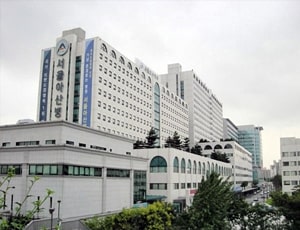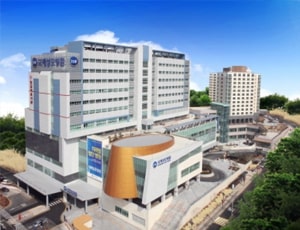Treatment cost

Asan Medical Centre located in Seoul, South Korea is accredited by ISO. Also listed below are some of the most prominent infrastructural details:


International St. Mary's Hospital located in Seoul, South Korea is accredited by JCI. Also listed below are some of the most prominent infrastructural details:
When a mother delivers her baby without any surgical intervention, it is called a normal delivery. There are many factors associated with pregnancy and birth which make the difference between normal delivery and c-section delivery. The age of the mother, the position of the baby, the health parameters of mother and baby and the term of the pregnancy, etc.
There are several stages of the labour and delivery process when a woman gives birth to a baby through normal delivery.
First Stage: Labour and effacement of the cervix: During this stage, the cervix dilates and even becomes softer. The first stage of labour can last for 12 to 13 hours when it is the first baby and for following deliveries it is usually around 8 hours or so (on average). This stage is divided into three parts and these are early labour, active labour, and the transition phase. Early labour is when the contractions come after a gap of 5 minutes and the cervix ends up dilating to 4 centimeters. In the active labour phase of the delivery, the gap between the contractions goes down to 3 minutes and the cervix dilates to 7 centimeters. In the early phase of labour the mother can stay at home but when it gains speed to active labour she needs to reach the hospital as the time for delivery is near. The transition phase is when the cervix has dilated fully to 10 centimeters and the contractions come quickly at 2-minute intervals.
Second Stage: The mother pushes the baby out and the pushes are timed with every contraction. The baby comes out head first via the birth canal and sometimes an incision (episiotomy) needs to be made to make the vagina opening bigger to help the baby come out seamlessly.
Third Stage: Also called afterbirth, in this stage once the baby is born the placenta Is pushed out via the vaginal canal. It may be helped along by the doctor by putting pressure on the lower abdomen.
Although relatively safe, there are few complications and risks associated with normal delivery and these are,
The benefits of vaginal delivery are:
Ask your healthcare adviser for the best multiple options and choose the one that meets your expectations
The cost of Normal Delivery in Seoul may differ from one medical facility to the other. Some of the best hospitals for Normal Delivery offer a comprehensive package that covers the end-to-end expenses related to investigations and treatment of the patient. Typically, the package cost of Normal Delivery in Seoul includes the expenses related to the surgeon's fee, anesthesia, hospital, meals, nursing and ICU stay. Post-surgical complications, new findings and delayed recovery may have an impact on the total Normal Delivery cost in Seoul.
Many hospitals in Seoul perform Normal Delivery. The top hospitals for Normal Delivery in Seoul include the following:
The recovery of the patient many vary, depending on several factors. However, on an average, patient is supposed to stay for about 20 days in the country after discharge. During this time, the patient undergoes medical tests and consultations. this is to ensure that the treatment was successful and the patient us safe to return.
There are certain additional cost that the patient has to pay apart from the Normal Delivery cost. The per day extra expenses in Seoul per person are about 40 USD.
The patient is supposed to stay at the hospital for about 1 Days after Normal Delivery surgery for monitoring and care. This time frame is important for the patient to recover properly and feel comfortable after the surgery. With the help of several tests, it is determined that the patient is doing fine after the surgery and is okay to be discharged.
There are about 2 Hospitals in Seoul that offer Normal Delivery to international patients. These hospitals have the required infrastructure and a decided Normal Delivery unit where renal failure patients can be treated. These hospitals comply with all the rules and regulations as dictated by the regulatory bodies and medical association in Seoul
One of the most popular destinations for medical tourism in the world, Seoul, the capital of South Korea attracts around 60% of the patients traveling to the country for quality care. More than 2.76 million International patients travel to South Korea on average. This can be attributed to high-quality medical services, economical healthcare services, and affordable packages that combine both treatment and relaxation. The number of healthcare organizations in Seoul tally up to 21,507. Out of these, 14 are advanced hospitals that provide a range of healthcare services. The high success rate of cancer treatment, plastic surgery, and organ transplants attract the majority of foreign patients to Seoul. Hundreds and thousands of patients from abroad travel to Seoul for cosmetic and plastic surgery. The largest proportion of medical tourists belonged to China and the United States. The top hospitals in Seoul have well-trained medical staff along with coordinators that help international patients availing treatments without any issues.
Seoul has a wide network of internationally accredited hospitals that are using cutting-edge medical technology to treat patients. Some of the top hospitals in Seoul are:
The doctors in Seoul obtained their medical education and training from some of the most reputed medical institutions around the world. Some of the top doctors in Seoul are:
Seoul is a major healthcare center and is well connected to the major cities in the globe via air. You can reach the city by international flights. If you are planning to travel, then we can assist you in making the journey hassle-free.